As an Amazon Associate I earn from qualifying purchases.
Smoked venison jerky may well be the finest expression of this type of food. Lean, meaty, smoky, chewy and a little spicy, this is the Platonic Ideal of jerky. Here’s how to make it yourself.
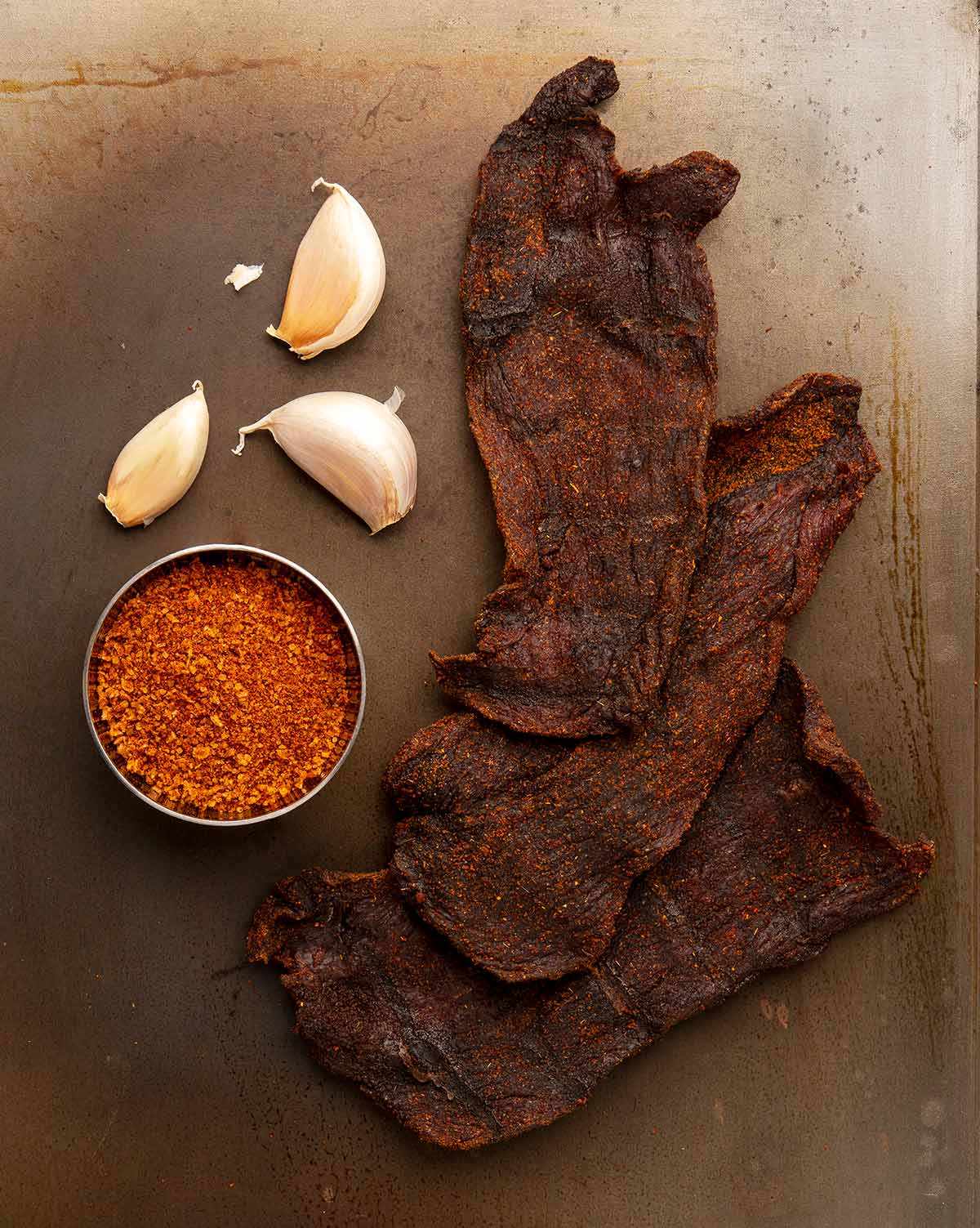
For starters, this is a regular, i.e., not ground meat, extruded venison jerky — my ground venison jerky recipe is here — and it is a dry cured jerky, not a brine-based one like my chipotle jerky.
You should know that either of those other recipes I just linked to can be made into smoked venison jerky, too. After all, the smoking step is merely an alternative method of drying your venison jerky.
The best meat for venison jerky, in my opinion, are slices from whole muscle roasts from the animal’s hind leg. These will be clean of sinew, and you can easily slice them across the grain, which makes them easier to eat.
It doesn’t matter what animal you are using, either. I’ve made “venison” jerky out of deer, yes, but also antelope, elk, moose, nilgai, bison, etc. And there is no reason you can’t use caribou, wild goat or sheep, or hell, beef. Any red meat works — and yes, that means slices of Canada goose breast work really well, too.
When you are making slices for smoked venison jerky, you will want to only partially thaw your roasts. When they are sort of half-frozen, it is far easier to make nice, even slices. I like them around 1/4 inch thick, which results in a chewy jerky, not a brittle one.
In practical terms, this generally means 12 to 24 hours after you have moved a roast from the freezer to the fridge.
The spice mix I use changes pretty much every time I make smoked venison jerky. But it is always, more or less, like Mexican Tajin, which is a combination of powdered chiles, lime and salt. I almost always add either mashed, pounded fresh garlic or garlic powder. The fresh, mashed garlic will give you a stronger garlic flavor.
For the acidity, you can do one of a few things. You can either wet your venison with vinegar or citrus juice, or you can include citric acid in your spice blend. I do this here, using Fruit Fresh, which you can find in the canning section in your local supermarket.
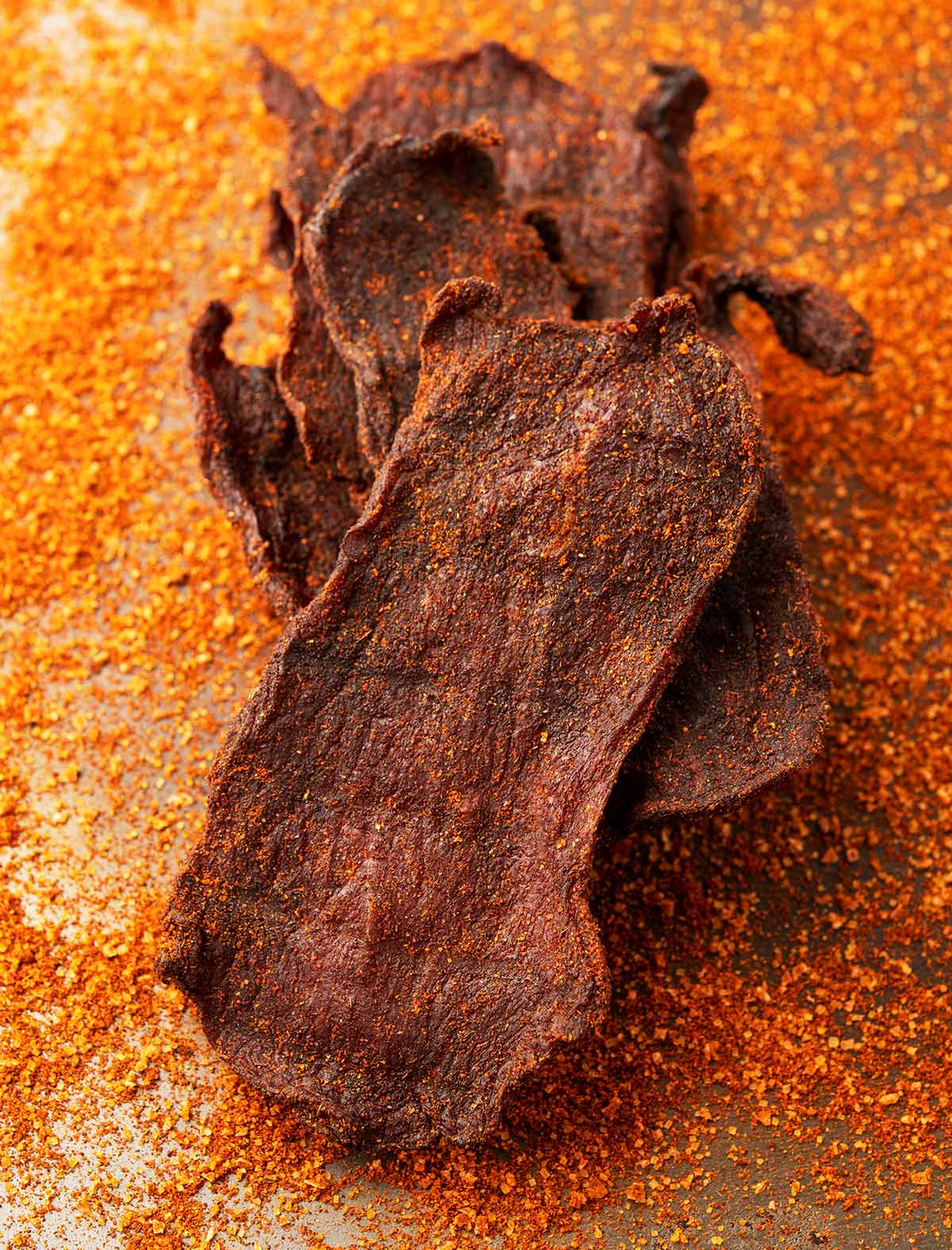
And remember, there is no shame in simply making smoked venison jerky with salt and black pepper alone.
As for the smoke, remember you are drying the venison here, not really cooking it — although yes, it gets cooked. That means you want your smoker relatively cool; I use a Traeger Timberline, and I keep it at 165°F on full smoke. No matter what you do, you want the smoker under 200°F.
Wood choice is up to you, but here I really do like mesquite, hickory and pecan, which are all assertive woods. Fruit and nut woods are all good choices. I’d avoid alder here, as it’s a little “meh” for smoked venison jerky.
Once made, the jerky will keep for months in the fridge, weeks at room temperature, and until the Second Coming in the freezer.
Smoked Venison Jerky
Ingredients
- 5 pounds venison, sliced against the grain 1/4 inch thick
- 1/2 cup lime or lemon juice (see below)
- 1/2 cup salt
- 1/4 cup paprika
- 2 tablespoons cayenne or other chile powder
- 2 tablespoon garlic powder, or 8 garlic cloves, minced and mashed
- 1 tablespoon black pepper
- 1 tablespoon dried oregano (optional)
- 1 tablespoon citric acid (optional)
Instructions
- Mix all the spices together in a bowl. If you are not using the citric acid powder (Fruit Fresh), wet the slices of the venison with the lime juice. Coat the venison with the spice mix well, pressing and massaging it into the meat. Put all this in a covered container in the fridge for a day, and up to 2 days. More than that and things might get too salty.
- Get your smoker going at about 165°F and no hotter than 200°F. Wood choice is up to you, but I like mesquite. Remove the meat from the container and shake off any excess spices; you do want some on there, though. Lay the meat out in the smoker so they are not touching. Smoke until leathery, so not juicy and not brittle. Start checking on the meat at 2 hours, then every 20 minutes past that.
- Once the jerky is to your liking, let this cool to room temperature before you put in the fridge.
Notes
Keys to Success
- Definitely pay attention to your meat when slicing. No sinew or silverskin! For those of you who get a lot of deer in a year, backstrap is great for this. I mostly use roasts from the hind leg.
- Keep the salt to meat ratio as it is in this recipe, but the other spices you can play with. Some variations could be to add allspice or coriander, cinnamon, or hell, just use Tajin from a Mexican market.
- You can also soak your meat in soy sauce plus 1/2 cup of sugar, let it sit no longer than 8 hours, then smoke it. Soy is very salty, so you don't want to oversoak it.
- Definitely try a batch with just the salt and black pepper once. It really shows off the quality of your venison.
Nutrition
Nutrition information is automatically calculated, so should only be used as an approximation.

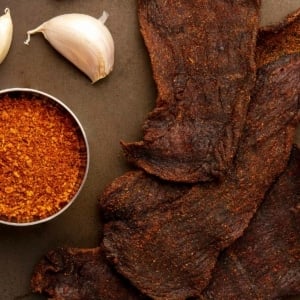
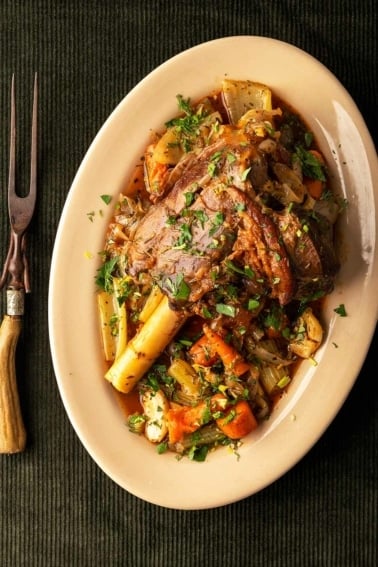
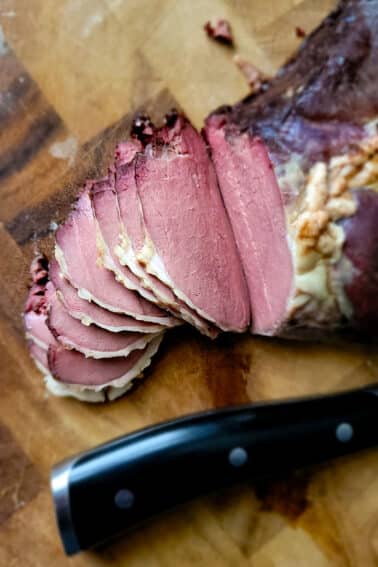

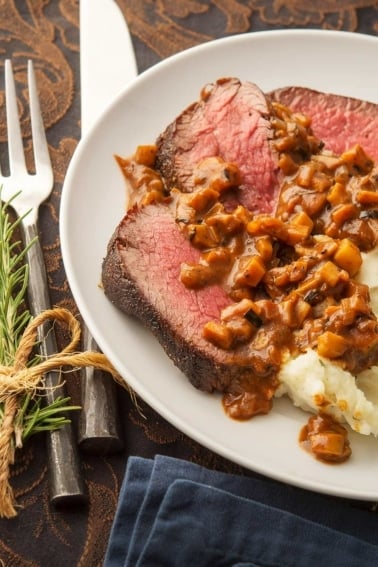
salt. are you talking table, kosher, curing? l
Brian: I use Diamond Crystal kosher salt.
Super deer jerky !
Was about to make jerky and came here for the recipe. Couple of things:
Fruit Fresh is a valuable ingredient but citric acid is, while the most important ingredient, not the primary ingredient – if it was, the nine year old me who loved to eat it would have been very disappointed. I use citric acid for a lot of things – buy it by the kilo – one tablespoon of citric acid is very (very) different than one tablespoon of fruit fresh.
One reviewer complained of saltiness and in another response you said salt should be sea or kosher. Kosher salt can’t be measured by volume across different manufacturers because the differences in manufacturing processes create different sizes of crystals. It was either Gourmet or Bon Appetite who discovered this when investigating why so many readers were complaining about their recipes – they converted all recipes to Diamond Crystal and provided a conversion formula for Morton.
I really enjoy your site and look forward to your future articles!
Hi Hank,
Love this recipe, super tasty but turned out very salty. Couple of questions for you about reducing the saltiness. Could I use the recipe as is, but rinse the meat prior to smoking?
Can I substitute some brown sugar for a portion of the salt? If so, best to do by wt. or vol.?
Lastly, I’ve made your salmon jerky and smoked turkey breast multiple times with great results. Wondered why there is no mention of forming a pellicle on the jerky prior to smoking.
Thanks a bunch. Tight lines and happy trails.
Dan: Yes, you can rinse it. And you could sub in about 1/3 of the salt for brown sugar, too. I don’t bother with the pellicle because with jerky you are not really going for that classic “smoked food” finish. You are just using a smoker to dry the meat.
I am sorry, I appreciate you posting this, I followed it to a T, came out way over seasoned. Definitely will be trying a different recipe in the future
Hello Hank
I used this recipe on some Axis deer we have here in Texas Hill Country and it came out amazing. I used a Recteq Wood Pellet Grill called the Bully. It’s even more convenient than the Traeger as it connects to your home wifi and you can set timers and monitor temperatures from your cell phone.
I made this yesterday. Loved the flavor! So different from my usual recipe. Real smoke is a huge improvement over liquid smoke, and I will do this again. I used apple wood and mesquite. It was 100% humidity here, and raining, so I gave up trying to dry it in the smoker after 6 hours. I had to bring it inside and finish in the dehydrator. Still a success.
Damn, Man, what a recipe. Didn’t have the time to tend the smoker, so did a half recipe, sliced up a couple pounds sirloin steak, added 2 tsp liquid smoke (I know!), brine overnight, put in the dehydrator for about 7 hours. S.O. says the best jerky I’ve ever made, and I’ve made quite a few. I’ll try it your way next week.
Have you ever done a write-up on the Traeger or other grills/smokers? My old Weber bit the dust this winter and I need to replace it. I’m curious about the functioning of the Traeger and if it’s worth the price.
John: I have a Traeger, and I like its convenience. They are great smokers and great for BBQ, but you would need a second grill for direct, open fire cooking.
Is there any difference or benefit to hanging the strips as opposed to laying them flat when smoking?
Daniel: Only in that you will not have grate marks on your finished venison if you hang them.
Awesome recipe! Still have not tried one of Hank’s recipes that have not been a big hit!
It’s better to cut meat that has been partially frozen .. and not partially thawed
..in other words, start freezing the meat and cut it after it’s partially frozen
Just did a batch of your recipe using the chipotles in adobo. Smoked over mesquite and turned out phenomenally. Wondering why you don’t include cure in this recipe?
Alex: In this particular case it’s not 100% needed. You could add it if you wanted to.
Hi Hank, why no Prague powder #1?
Also, Kosher or table salt? Is the ratio of meat to salt critical? I have 5 lbs 11 oz of round thawing to try this recipe.
Matt: In this case, it’s not needed. You can add a half teaspoon if you want. Always kosher salt, or sea salt.
Great reminder that just salt and pepper are an option. I’ve used that plus a little Worcestershire sauce for many years. Especially before I could afford a smoker or food dehydrator.
I don’t have a smoker but was wondering of liquid smoke could be used instead? If so how much of the liquid smoke should be put in the marinate??
Nicole: Yes, but you are on your own. I hate the stuff. Start with a little, since you can add more on the next batch if it’s not enough.
Hello, I’ve made jerky a couple of times, using a Weber kettle for smoking and drying, and also a dehydrator. In looking at several jerky recipes (not the extruded kind) the recipes always say to trim all the fat off the meat. That might be why it’s easier to make jerky from duck and goose breasts – pull off the skin and the fat goes with it. Hope this helps.
Steve
P. S. I have to say this venison jerky looks good – now all I have to do is find somewhere here in the Twin Cities where I can buy that Tajin seasoning.
Stephen: They sell it at El Burrito Mercado in St. Paul.
El Burrito Mercado, hah! I should have guessed. I used to go there for lunch while I was still working (downtown St. Paul). A couple of questions about the recipe. First, if you are going to use the citric acid powder, do you still add the lime juice? I don’t see it in the recipe. Then, if you use the Tajin (I got it), do we still add the 1/2 cup of salt? The Tajin has a fair amount of salt, but probably not enough for the dry rub. (If I don’t need the lime juice because I use citric acid powder, I’ll make a couple of Margaritas and sprinkle some Tajin on top.)
Thanks for everything, Steve
I love the simplicity of this-
Is there something in smoke that makes it, preservation-wise, different from a dehydrator at same temp?
Is belly meat ok for this? (Tried making lamb bacon from it- failed miserably)
Should any fat be trimmed?
Does it ruin the preservation of acid plus salt plus drying/smoking?
Tuffy: Yes, smoke inhibits some bacterial growth. I would not use belly. I would use mostly, or entirely, lean meat because the fat can go rancid over time.
Hank, I’ve never had a bad recipe from you! Love every one we have tried.
Just a note on the smoker for “drying” here. I have for quite a few years now, smoked my jerky with little to no heat(Bradley smoker) for a couple of hours, then pulled it and put it in the dehydrator to dry it. It is a great alternative option to keep from “cooking” it.
Keep doing what you do Hank!